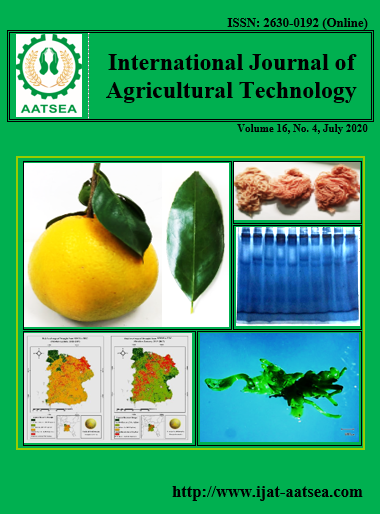In vitro screening of potential probiotic lactic acid bacteria isolated from intestinal contents and gills of Nile tilapia
Main Article Content
Abstract
The potential probiotic lactic acid bacteria (LAB) were isolated from intestinal contents and gills of Nile tilapia (Oreochromis niloticus). Those properties included antagonistic activity against pathogenic bacteria, tolerance to pH, NaCl, fresh bile from Nile tilapia. Moreover, drug resistance profiles were examined. A total of forty isolates were collected. LAB isolated from the intestinal contents showed inhibitory activity against Bacillus coagulans TISTR1447, Pseudomonas fluorescens TISTR358 and Salmonella Typhimurium TISTR292, whereas those from the gills revealed only antagonistic activity against Bacillus coagulans TISTR1447, S. Typhimurium TISTR292 and Escherichia coli TISTR780. Isolates LI10 and LG5 were selected for further evaluation of probiotic properties. Both isolates could grow in pH 4–10, NaCl concentration up to 10% and fresh bile concentration up to 10%. These isolates were resistant to cefovecin, marbofloxacin, clindamycin and trimethoprim/sulfamethoxazole, meanwhile they were susceptible to benzylpenicillin, amoxicillin/clavulanic acid, vancomycin, tetracycline, nitrofurantoin and chloramphenicol. In addition, both isolates were identified by Matrix-assisted lazer desorption/ionization-time of flight mass spectrometry (MALDI-TOF MS) as Enterococcus feacalis. Therefore, these two isolates could potentially be used as probiotics.
Article Details

This work is licensed under a Creative Commons Attribution-NonCommercial-NoDerivatives 4.0 International License.
References
Abdel-Ghany, H. M., El-Sayedb, A. M., Ezzatb, A. A., Essaa, M. A. and Helala, A. M. (2019). Dietary lipid sources affect cold tolerance of Nile tilapia (Oreochromis niloticus). Journal of Thermal Biology, 79:50-55.
Allameh, S. K., Daud, H., Yusoff, F. M. Saad, C. R. and Ideris, A. (2012). Isolation, identification and characterization of Leuconostoc mesenteroides as a new probiotic from intestine of snakehead fish (Channa striatus). African Journal of Biotechnology, 11:3810-3816.
Arumugam, U., Stalin, N. and Rebecca, G. P. (2017). Isolation, molecular identification and antibiotic resistance of Enterococcus faecalis from diseased tilapia. International Journal of Current Microbiology and Applied Sciences, 6:136-146.
Balcázar, J. L., Vendrell, D., Blas, I., Ruiz-Zarzuela, I., Muzquiz, J. L. and Girones, O. (2008). Characterization of probiotic properties of lactic acid bacteria isolated from intestinal microbiota of fish. Aquaculture, 278:188-191.
Delphino, M. K. V. C., Leal, C. A. G., Gardner, I. A., Assis, G. B. N., Roriz, G. D., Ferreira, F., Figueiredo, H. C. P. and Gonçalves, V. S. P. (2019). Seasonal dynamics of bacterial pathogens of Nile tilapia farmed in a Brazilian reservoir. Aquaculture, 498:100-108.
Ehrmann, M. A., Kurzak, P., Bauer, J. and Vogel, R. F. (2002). Characterization of lactobacilli towards their use as probiotic adjuncts in poultry. Journal of Applied Microbiology, 92:966-975.
El-Naby, A. S. A., Khattaby, A. E. R. A., Samir, F., Awad, S. M. and Abdel-Tawwab, M. (2019). Stimulatory effect of dietary butyrate on growth, immune response, and resistance of Nile tilapia, Oreochromis niloticus against Aeromonas hydrophila infection. Animal Feed Science and Technology, 254:1-5.
Ennahar, S., Asou, Y., Zendo, T., Sonomoto, K. and Ishizaki, A. (2001). Biochemical and genetic evidence for production of enterocins A and B by Enterococcus faecium WHE 81. International Journal of Food Microbiology, 70:291-301.
Fuller, R. (1989). A review: probiotics in man and animals. Journal of Applied Bacteriology, 66:365-378.
Holzapfel, W. H. and Wood, B. J. B. (1995). Lactic acid bacteria in contemporary perspective. In: B.J.B. Wood and W.H. Holzapfel (eds). The Lactic Acid Bacteria. Blackic Academic and Professional, London, pp. 1-6.
Hyronimus, B., Le Marrec, C., Sassi A. H. and Deschamps, A. (2000). Acid and bile tolerance of spore-forming lactic acid bacteria. International Journal of Food Microbiology, 61:193-197.
Ige, B. A. (2013). Probiotics use in intensive fish farming. African Journal of Microbiology Research, 7:2701-2711.
Klein, G., Pack, A., Bonaparte, C. and Reuter, G. (1998). Taxonomy and physiology of probiotic lactic acid bacteria. International Journal of Food Microbiology, 41:103-125.
Mouriño, J. L. P., do Vale Pereira, G., do Nascimento Vieira, F., Jatobá, A. B., Ushizima, T. T., da Silva, B. C., Seiffert, W. Q., Jesus, G. F. A. and Martins, M. L. (2016). Isolation of probiotic bacteria from the hybrid South American catfish Pseudoplatystoma reticulatum × Pseudoplatystoma corruscans (Siluriformes: Pimelodidae): A haematological approach. Aquaculture Reports, 3:166-171.
Narakaew, T., Pilasombut, K., Ngamyeesoon, N. and Swetwiwathana, A. (2010). Preliminary characterization of Lactobacillus salivarius K7 for probiotic properties. Khon Kaen University Research Journal, 15:878-888.
Nayak, S. K. (2010). Probiotics and immunity: A fish perspective. Fish and Shellfish Immunology, 29:2-14.
Pan, X., Wu, T., Zhang, L., Song, Z., Tang, H. and Zhao, Z. (2008). In vitro evaluation on adherence and antimicrobial properties of a candidate probiotic Clostridium butyricum CB2 for farmed fish. Journal of Applied Microbiology, 105:1623-1629.
Prabhurajeshwar, C. and Chandrakanth, R. K. (2017). Probiotic potential of Lactobacilli with antagonistic activity against pathogenic strains: An in vitro validation for the production of inhibitory substances. Biomedical Journal, 40:270-283.
Ruiz-Moyano, S., dos Santos, M. T. P. G., Galván, A. I., Merchán, A. V., González, E., de Guía Córdoba, M. and Benito, M. J. (2019). Screening of autochthonous lactic acid bacteria strains from artisanal soft cheese: probiotic characteristics and prebiotic metabolism. Food Science and Technology, 114:108-388.
Rumjuankiat, K., Ngamyeesoon,N., Swetwiwathana, A. and Pilasombut, K. (2017). Study for probiotic properties of Lactobacillus salivarius KL-D4 isolated from duck intestine. International Journal of Agricultural Technology, 13:823-837.
Verschuere, L., Rombaut, G., Sorgeloos, P. and Verstraete. W. (2000). Probiotic bacteria as biological control agents in aquaculture. Microbiology and molecular biology reviews, 64:655-671.
Zorriehzahra, M. J., Delshad, S. T., Adel, M., Tiwari, R., Karthik, K., Dhama, K. and Lazado, C. C. (2016). Probiotics as beneficial microbes in aquaculture: an update on their multiple modes of action: a review. Veterinary Quarterly, 36:228-241.


